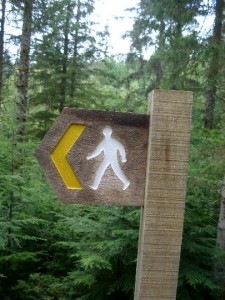Posted by Teresa on July 12, 2010 under Housing Trends, Landlord Tips | 
 When it comes to advertising a rental property, most landlords are sure to include the basics: the number of bedrooms and bathrooms, any included appliances, and of course, the area of town or neighborhood it’s in.
When it comes to advertising a rental property, most landlords are sure to include the basics: the number of bedrooms and bathrooms, any included appliances, and of course, the area of town or neighborhood it’s in.
But you might be surprised to hear that potential tenants also want to know about an area’s walkability rating. What’s that? Walkability is a way to determine how close a property is to shops, grocery stores, libraries, and other amenities that people want. If you can get there by leaving the car in the garage, it’s walkable—and the more amenities within walking distance, the higher a property’s walkability rating.
Walkability means that tenants can avoid the congestion, parking, and pollution associated with driving—and still get their errands run. Walkability makes a neighborhood more pleasant to live in—and studies show that more amenities within walking distance can boost home values. Given that tenants want walkable residences, you might want to advertise the walkability rating for all your rental properties.
How do you know if your vacant rental is in a walkable neighborhood? It’s quick and easy on WalkScore.com, a popular site that measures how many amenities are within walking distance of any address. While the site’s algorithm gives the actual distance from an address to stores, restaurants, movie theaters and public transportation, it doesn’t factor in safety, street design or topography. So, it won’t mention any huge hills you’d have to climb to reach the nearest bookstore.
While WalkScore.com will likely add improvements like topography and presence of sidewalks, it’s still a clear snapshot of the amenities surrounding your rental property. Whether or not you include a walkability rating in your rental ads, consider using this tool to inform potential tenants of all the great stores, restaurants, and coffee shops that are close to your rental units.
Posted by Teresa on June 12, 2010 under General | 
 When it comes to advertising your vacant rental units, there is only one way to measure an ad’s effectiveness—it’s making your phone ring! If your attempts to promote your rental property aren’t doing that, then you need to change tactics—and fast.
When it comes to advertising your vacant rental units, there is only one way to measure an ad’s effectiveness—it’s making your phone ring! If your attempts to promote your rental property aren’t doing that, then you need to change tactics—and fast.
Tracking where your inquiries come from is an important side note here. If you’re not tracking sources, you don’t know which of your advertising dollars are working hard and deserve to keep going, and which you should retire.
Here are some advertising methods that work for the landlords we talk to. And keep in mind that in different areas, costs and effectiveness vary greatly. All you can do is keep track of what works for you.
Banners: There’s nothing like a large, colorful banner to grab the attention of drivers and pedestrians. No matter what size building it’s on, a proportionately-sized banner can really work. Make sure you word it in a generic way—today’s tough vinyl materials are meant to last, so don’t advertise any short-term rental deals, unless you plan to repeat them and re-use the banner.
Signs: Inexpensive plastic “For Rent” signs can be scattered throughout your property, or just placed in front near the sidewalk. But just don’t expect these to last—they tend to “walk away” and are meant to be temporary. Still, they do a good job of garnering attention. You can also place them in the windows of vacant units—so they cannot be stolen or blown away. Visibility could be less, but you’ll keep the signs longer! Some rental managers place “for rent” arrow signs at intersections; you should check the legality of this practice in your city.
Referral fees: offer your staff and current tenants a token of your appreciation for bringing in solid tenants. Knowing your minimum requirements is important, so be clear on your expectations. And of course, keep the Fair Housing Act in mind at all times, and don’t ever indicate a preference for one group over another.
“For Rent” publications: These specialized publications are typically used by multi-family complexes. They tend to be pricier than other advertising methods. But since calls can be directed to special numbers, you can easily track how well these ads are doing. The rental publications also give you the advantage of high production values, photos, and wide distribution.
Advertising can be cheap, free, or very expensive. Tracking ads is vital to keeping your rental property business profitable.
 When it comes to advertising a rental property, most landlords are sure to include the basics: the number of bedrooms and bathrooms, any included appliances, and of course, the area of town or neighborhood it’s in.
When it comes to advertising a rental property, most landlords are sure to include the basics: the number of bedrooms and bathrooms, any included appliances, and of course, the area of town or neighborhood it’s in.
